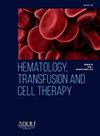A NEW LOOK AT THE TREATMENT OF PATIENTS WITH ACUTE LEUKEMIA
IF 1.6
Q3 HEMATOLOGY
引用次数: 0
Abstract
Objective
For the first time, we had to organize an induction period for the treatment of acute leukemia in an outpatient setting. The reason was the problems that arose during the hospitalization of patients during COVID-19 infection. to study the effectiveness of the obtained results and to find out the possibility and importance of widespread use of this tactic in the future.
Methodology
The study group included 25 patients diagnosed with acute leukemia. Among them, 21 patients had lymphoblastic leukemia (19 patients with B-cells, 4 patients with T-cells), 2 patients with myeloblastic leukemia (1 patient with M2, 1 patient with promyelocytic leukemia M3). The age range of the patients was from 2 years to 2 months to 15 years (median = 8.5-years). The male/female ratio was 10/15. Treatment of acute lymphoblastic leukemia was carried out according to the Moscow-Berlin-2015 program, the B-ImRG protocol was used in 15 patients, the A-SRG protocol in 2 patients, Bt(12:21) in 2 patients, the T-Low protocol in 1 patient and protocol T-ImRG in 3 patients. In one of the patients with Myeloblastic leukemia (M2), the “7+3” protocol was used, in the other (M3) the APL-.2000 protocol was used.
Results
Obtained showed that the induction period of treatment for patients with acute leukemia can be carried out completely on an outpatient basis. The organization of treatment in the “day hospital + night outpatient” format made it possible to carry out both the main treatment (chemotherapy) and concomitant therapy in a timely and without problems. Replacing intravenous “flush therapy” with oral fluids did not cause serious problems, including “lysis syndrome”. The initial leukocyte count (10.6‒116 × 109/l), as well as the level of blastemia (4%‒99%) and blastosis (45.4%‒96.8%) did not cause serious concern in any patient, despite the standard of concomitant therapy. Biochemical parameters, including nitrogen metabolism parameters, fluctuated within normal limits in all patients. In all patients, the induction course was carried out to the end and ended in complete remission.
Conclusion
The results showed the possibility and prospects of further expansion of outpatient treatment of patients with acute leukemia.
治疗急性白血病的新方法
目的首次在门诊组织急性白血病的诱导期治疗。原因是新冠肺炎感染期间患者住院期间出现的问题。对所得结果的有效性进行了研究,并探讨了该策略在今后推广应用的可能性和重要性。方法研究组纳入25例诊断为急性白血病的患者。其中淋巴母细胞白血病21例(b细胞19例,t细胞4例),髓母细胞白血病2例(M2 1例,早幼粒细胞白血病M3 1例)。患者年龄范围为2岁~ 2个月~ 15岁(中位 = 8.5岁)。男女比例为10/15。根据莫斯科-柏林-2015方案治疗急性淋巴细胞白血病,15例患者采用B-ImRG方案,2例患者采用A-SRG方案,2例患者采用Bt(12:21)方案,1例患者采用T-Low方案,3例患者采用T-ImRG方案。1例髓母细胞白血病(M2)采用“7+3”方案,另1例(M3)采用APL-。采用2000年的协议。结果急性白血病患者的诱导期治疗完全可以在门诊基础上进行。以“日间医院 + 夜间门诊”的形式组织治疗,可以及时、无问题地进行主要治疗(化疗)和伴随治疗。用口服液代替静脉“冲洗疗法”不会造成严重问题,包括“溶解综合征”。初始白细胞计数(10.6-116 × 109/l)以及囊胚血症(4%-99%)和囊胚形成(45.4%-96.8%)水平在任何患者中都没有引起严重的担忧,尽管有标准的伴随治疗。所有患者的生化参数包括氮代谢参数均在正常范围内波动。在所有患者中,诱导疗程进行到最后,并以完全缓解结束。结论进一步扩大急性白血病门诊治疗的可能性和前景。
本文章由计算机程序翻译,如有差异,请以英文原文为准。
求助全文
约1分钟内获得全文
求助全文
来源期刊

Hematology, Transfusion and Cell Therapy
Multiple-
CiteScore
2.40
自引率
4.80%
发文量
1419
审稿时长
30 weeks
 求助内容:
求助内容: 应助结果提醒方式:
应助结果提醒方式:


